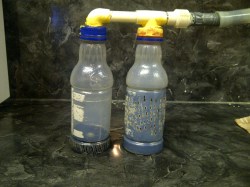![]()
The race is on to squeeze cycles out of an 8MHz AVR chip in order to better drive the WS2811 LED protocol.
[Asher] doesn’t want to buy charcoal aquarium filters if he can just build them himself. He filled a couple of plastic drink bottles with charcoal, cut slots in the sides, and hooked them up to his pump system. A gallery of his work is available after the break.
Is the best way to make microscopic sized batteries to 3d print them? Harvard researchers think so. [Thanks Jonathan and Itay]
The Ouya gaming console is now available for the general public. [Hunter Davis] reports that the Retrode works with Ouya out-of-the-box. If you don’t remember hearing about it, Retrode reads your original cartridge ROMs for use with emulators.
Making a cluster computer out of 300 Raspberry Pi boards sounds like a nightmare. Organization is the key to this project.
Hackaday alum [Jeremy Cook] is working on an animatronic cigar box. Here he’s demonstrating it’s ability to listen for voice commands.
A Kelvin clips is a type of crocodile clip that has the two jaws insulated from each other. [Kaushlesh] came up with a way to turn them into tweezer probes.




















Kelvin clips into tweezer probes?
“I’m going to take a clip that has two conductors, and use it as a clip with two conductors.” These look like eBay-direct-from-China kelvin clips (often kelvin clips are unusually expensive) and considering his time and how much those cost, it’s hard to argue with the fact that even Pomona-brand tweezer clips are only $20.
$40 (for two Pomona tweezers) or $5 (make it $8 including wire and shrink tubing) and some handiwork: easy equation, I guess?
The only thing he could’ve done better is to take both clips apart and put black and red together to avoid colouring one half of the red clip and get black fingers while using them (his eBay link shows a red and a black clip for under $5)
http://www.ebay.com/itm/SMD-Test-Clip-Meter-Probe-Multimeter-Tweezer-Capacitor-/130569383037?pt=LH_DefaultDomain_0&hash=item1e668aac7d
$4 for ready-made ones :P
charcoal != activated charcoal
Agreed.
I can just imagine what’s going through that fishes mind, “Man, this neighbourhood has really gone down hill!’
Activating charcoal requires a cd key.
LOL’d.
300 Raspis, srsly? Sure you don’t have more computing power with even a single high-power graphics card? any experts here?
Yeah. It isn’t a good idea to cluster Raspberry Pi boards unless you’re actually doing research into clustering itself where you need a large number of nodes. The performance won’t linearly scale and you’ll be severely bottlenecked by the USB based 100mbps Ethernet.
A huge problem that they’ve not considered is that Folding@home don’t actually support any CPU apart from x86 and x86_64. Even if it did, it wouldn’t support the Raspberry Pi GPU.
The fact that this project is funded from University’s research money makes me cry.
They’ll probably reuse the RasPi’s for a robotics class when they’re done with the cluster.
The fact that it’s in my country makes it worse for me.
I’m no expert here, but i doubt this can be a good idea. We already talked about this here on HaD. I’d really like who puts up projects like this to show some data about how they thing it’s a good choice.
“Our main goal will be to help the Stanford University in their project “Folding@home”, by helping with calculations for their research into protein folding.”
It’s not an academic experiment on clusters, they actually want to process data.
General purpose gpu computing is pretty amazing but restrictive in terms of memory usage (each processor has a tiny amount of memory that it can access efficiently, the rest is shared with others and slower). Most parallel algorithms that work on multiple normal cpu’s have to be seriously re-thought in order to work on a gpu.
well, te biggest restriction will be NO DRIVERS for OpenCL on RPi
Yeah, I’m guessing that for 10k USD (300 x 35 USD) you can get a LOT more computation power with normal off the shelf hardware.
..smallest pc in the world?